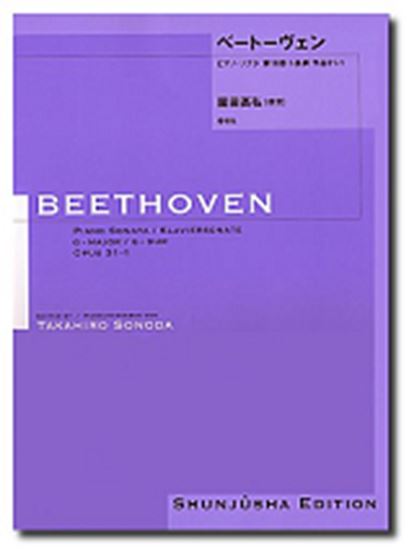Beethoven, Ludwig van : Sonate für Klavier Nr.16 G-Dur Op.31-1
Work Overview
Publication Year:1803
First Publisher:Simrock
Instrumentation:Piano Solo
Genre:sonata
Total Playing Time:23 min 30 sec
Copyright:Public Domain
Additional Notes:スイスのジャン・ジョルジュ・ネーゲリ社から同年4月に出版され、ジムロックは2ヶ月後の6月に初版譜を出版している。ネーゲリ社は「2つのソナタ」としてop.31-1とop.31-2を出版し、ジムロック社はop.31-3を含む3曲をまとめて出版した。 平野昭氏によれば、両者にはかなりの相違(誤植)があるという。(『ベートーヴェン事典』、東京書籍刊、401頁)(2008/11 岡田)
Commentary (1)
Author : Okada, Akihiro
Last Updated: July 1, 2009
[Open]
Author : Okada, Akihiro
For Beethoven, 1802 is known as the year of the "Heiligenstadt Testament." Although Beethoven seriously contemplated suicide due to unfortunate personal circumstances, including his ear disease, his creative output was surprisingly prolific, as evidenced by the completion of the three Violin Sonatas, Op. 30.
Although the exact dates of composition and completion for the three sonatas published as Op. 31 are uncertain, it can be inferred that at least one sonata was completed or nearing completion by April 22, 1802, when his brother Karl wrote a letter to Breitkopf & Härtel offering the three works for sale.
First Movement: G major, 2/4 time, Sonata Form
(Exposition)
The principal theme (mm. 1-11), which begins with a highly distinctive motif featuring a single sixteenth-note anacrusis, consists of this rhythmic motif and a descending sixteenth-note figure incorporating chromatic alterations. This theme is immediately restated a major second lower in F major (m. 12ff.), and after an improvisatory development of the descending figure, it is restated once more in the tonic key (m. 46ff.).
The subordinate theme (mm. 66-73), which appears after the transition (mm. 55-65), is in B major, a major third above the tonic key (G major). It is restated in its parallel minor, B minor (m. 74ff.), and the coda (m. 98ff.) concludes directly in B minor.
(Development + Recapitulation)
In the development section (mm. 114[115]ff.), the rhythmic motif is first expanded and repeated across a wide range, after which the descending figure is transformed into a passage through improvisatory development. As the dominant chord of the tonic key is arpeggiated, the rhythmic motif is extended by two dotted notes (the dominant) and quarter-note dominant chords, preparing for the recapitulation while reducing the dynamics to pp (pianissimo).
The recapitulation (m. 194ff.) begins resolutely with ff (fortissimo). The restatement section is omitted, and it immediately transitions. However, instead of passing through the subdominant key, which would be necessary to return the subordinate theme in the tonic, the subordinate theme first returns in E major/E minor (m. 218ff.). Then, by altering the latter half of the restatement section (m. 232ff.) from the exposition in E minor, the subordinate theme finally appears in the tonic key.
In this sonata, too, the coda is expanded, and the movement concludes with the development of the rhythmic motif, following the return of the principal theme, a passage of the descending figure, and arpeggios of the dominant chord.
Second Movement: C major, 9/8 time
This is a slow movement of a free, fantasia-like character, structured such that the theme returns multiple times in a rondo-like fashion.
The theme, characterized by a long trill and a chromatic ascending figure, returns a total of three times thereafter. The first and third returns occur after cadenza-like passages. The insertion of such cadenza passages, as seen in Op. 27, indicates the "fantasia-like" nature of this movement.
Third Movement: G major, 2/2 time, Rondo
Although marked 'Rondo,' it is a sonata-rondo.
The rondo theme (mm. 1-16), written in a polyphonic style, is characterized by a dominant pedal point. The restatement of the theme in the lower voice (m. 16ff.) is accompanied by an ornamental phrase of eighth-note triplets, which subsequently becomes the motif for the theme in the dominant key.
In the first return of the rondo theme (m. 66ff.), the accompaniment figure consists of arpeggiated eighth-note triplets. In the second return (m. 132ff.), after developing through repeated modulations, the theme is octave-doubled, and the accompaniment figure transforms into an octave tremolo of eighth-note triplets.
In the coda, motifs from the rondo theme appear alternately in Adagio and Tempo Primo. It eventually becomes Presto, and the movement concludes with the persistent repetition of the opening motif of the rondo theme, accompanied by a long trill on the dominant over the tonic.
The fantasia-like middle movement and the finale expanded by sonata-rondo form seem to be a style inherited from Op. 27 and Op. 28. However, the tempo changes in the finale's coda appear in a more stylized manner in Op. 31 No. 2 (the 'Tempest' Sonata).
Furthermore, the repetition of the principal theme a major second lower in the first movement and the choice of a key a major third above the tonic for the subordinate theme certainly foreshadow Op. 53 (the 'Waldstein' Sonata). However, this sonata leaves many challenges unresolved, such as the characteristic omission of the restatement and the non-straightforward recapitulation of the subordinate theme, suggesting that it was still in an experimental stage.
Movements (3)
PTNA & Partner Channel Videos(6items)
Reference Videos & Audition Selections(7items)
Sheet Music
Scores List (11)

(株)全音楽譜出版社

(株)春秋社

(株)全音楽譜出版社

(株)全音楽譜出版社

(株)音楽之友社

ヘンレ社(ヤマハ)

Barenreiter









